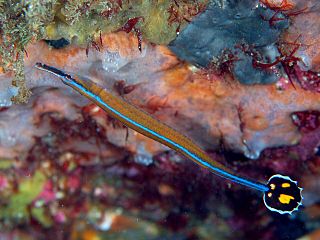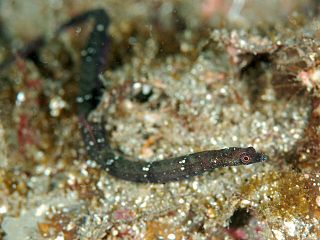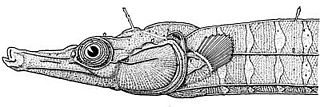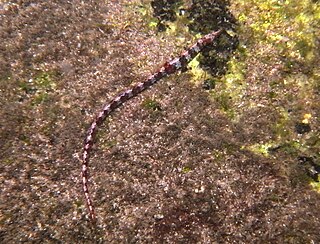
The Syngnathidae is a family of fish which includes seahorses, pipefishes, and seadragons. The name is derived from Greek, σύν (syn), meaning "together", and γνάθος (gnathos), meaning "jaw". This fused jaw trait is something the entire family has in common.

Pipefishes or pipe-fishes (Syngnathinae) are a subfamily of small fishes, which, together with the seahorses and seadragons, form the family Syngnathidae.

Syngnathus is a genus of fish in the family Syngnathidae found in marine, brackish and sometimes fresh waters of the Atlantic, Indian and Pacific Ocean. Fossils of these species are found from the Oligocene to the Pleistocene. They are known from various localities of Greece, Italy, Germany and United States.
Solegnathus is a genus of pipefish native to the Indian and Pacific Oceans.

Stigmatopora is a genus of pipefishes native to the Indian and Pacific Oceans.

Doryrhamphus and Dunckerocampus, popularly known as flagtail pipefish, are two genera of fishes in the family Syngnathidae. They are found in warm, relatively shallow waters of the Indo-Pacific, with a single species, D. paulus, in the eastern Pacific. Most of these pipefishes are very colourful, and are fairly popular in the marine aquarium hobby despite requiring special care and not being recommended for beginners.

Doryrhamphus is a genus of pipefishes, one of the two genera colloquially known as flagtail pipefishes and are popular in the aquarium trade. The members of this genus are native to the Indian and Pacific Oceans where they inhabit reef environments. The species in this genus have a maximum length of 14 centimetres (5.5 in) or less, with D. janssi being the only species that surpasses 8.5 centimetres (3.3 in). Most species have a horizontal blue line along their body, and all have a whitish-edged tail that is marked contrastingly with black, red or yellow.
The chain pipefish is a pipefish species. It inhabits the western Atlantic from Virginia, Bermuda and northern Gulf of Mexico to Campeche and Jamaica, but is absent from the Bahamas. It is a marine subtropical reef-associated fish, up to 38 cm length.

Halicampus is a genus of pipefishes of the family Syngnathidae, containing 12 described species.
Choeroichthys is a genus of pipefishes of the family Syngnathidae native to the Indian and Pacific Oceans.

Cosmocampus is a genus of pipefishes.
Nannocampus is a genus of pipefishes native to the Indian and Pacific Oceans with these currently recognized species :
Lissocampus bannwarthi is a species of marine pipefish belonging to the family Syngnathidae.
Lissocampus caudalis, also called the Australian smooth pipefish or the smooth pipefish, is a species of marine fish belonging to the family Sygnathidae.
Lissocampus fatiloquus, also known as prophet's pipefish is a species of marine fish belonging to the family Syngnathidae. The species has been noted in a variety of habitats including sargassum, seagrass beds and sandy substrates along the coast of Western Australia from Shark Bay to Rottnest Island. Their diet is thought to consist of small crustaceans such as copepods. Reproduction occurs through ovoviviparity in which the males brood eggs before giving live birth.
Lissocampus filum, also known as the shortsnout pipefish, is a species of marine fish belonging to the family Syngnathidae. This species can be found in tidepools, algae beds, and estuaries in the coastal region surrounding New Zealand and the Chatham Islands. Its diet is thought to consist of small crustaceans such as copepods. The yellow-eyed penguin has been recorded as a predator of Lissocampus filum. Reproduction occurs through ovoviviparity in which the males brood eggs before giving live birth.

Lissocampus runa, also known as the javelin pipefish is a species of marine fish belonging to the family Syngnathidae. This species can be found in algae beds, rocky reefs, tidepools, and estuaries along the coast of southern Australia from Broken Head Nature Reserve in New South Wales to Rottnest Island, Western Australia. Their diet is thought to consist of small crustaceans such as copepods .Reproduction occurs through ovoviviparity in which the males brood eggs before giving live birth.
Maroubra perserrata, also known as the sawtooth pipefish is a species of marine fish belonging to the family Syngnathidae. This species can be found at depths up to 20 meters along the coast of Australia from southern Queensland to southern Western Australia. While they can live in many different habitats, they are often found inhabiting openings in reefs and rocks that contain algae and invertebrates, which they likely rely on for camouflage. Reproduction occurs through ovoviviparity in which the males brood eggs for roughly 22 days before giving live birth. Maroubra perserrata is considered more mobile than many pipefish species due to its prehensile tail and reduced caudal fin.
Stigmatopora nigra, also known as the wide-bodied pipefish is a species of marine fish belonging to the family Syngnathidae. This species can be found in the shallow waters, bays, and estuaries of southern Australia from Shark Bay to Brisbane, Tasmania, and New Zealand. They often inhabit seagrass or algae beds in addition to bare sand. Their diet consists of small crustaceans such as copepods and amphipods. Adult brooding males have been measured at 6.5-7 centimeters. Reproduction occurs through ovoviviparity. in which the males brood up to 25 eggs in a pouch below the tail before giving live birth. Stigmatopora nigra can live to 150 days old and are able to reproduce throughout the year.

Urocampus nanus, also known as the barbed pipefish, is a species of marine fish belonging to the family Syngnathidae. The species can be found inhabiting seagrass beds in sheltered shoreline and estuary habitats along the coasts of southern Japan and Korea. Their diet likely consists of small crustaceans. Reproduction occurs through ovoviviparity in which the males brood eggs for 11–16 days before giving live birth. Urocampus nanus is thought to be polyandrous, where multiple females compete over breeding with a single male.








